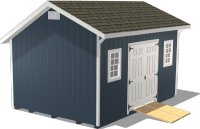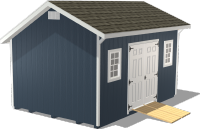From Coop to Egg: Exploring Backyard Chicken House Options
by Dakota Storage Buildings, on June 21, 2024

Selecting the appropriate chicken coop for your backyard flock is more than just a necessity — it is fundamental to the health and happiness of your flock. If you are new at chicken keeping, understanding the essential elements that contribute to a safe and nurturing environment for chickens is crucial. This blog is designed to be your ultimate guide, delving into the chicken coop options available, each with distinct advantages tailored to different needs. We will explore what makes each type unique, helping you to understand critical features and how they impact the daily life of your chickens. Our goal is to equip you with the knowledge to make an informed decision that ensures your backyard chickens thrive in a setting that is both safe and beneficial to their well-being.
Factors to Consider Before Buying Your Chicken Coop
Choosing the right chicken house is a pivotal decision in the journey of raising backyard chickens. It involves considering several key factors that directly impact the health and productivity of your flock.
Matching Coop Features to Your Flock’s Needs
Each chicken breed has their own unique challenges and requirements. For instance, heavy breeds like Orpingtons or Brahmas may need stronger perching areas, while breeds with thick feathering, such as Silkies, may require better-insulated coops to prevent overheating. Active breeds typically require more space to roam and engage in their natural behaviors, which keeps them healthy and happy. It is important to consider these specific needs to create an environment that reduces stress and promotes the well-being of each bird.
Ensuring Adequate Space for Your Chickens
When planning your coop, it is crucial to anticipate the number of backyard chickens you intend to keep. General space guidelines recommend 2-4 square feet per chicken inside the coop to avoid overcrowding, which can lead to health issues and aggressive behaviors. An additional 8-10 square feet per chicken in an outdoor run is advised for enclosed coops. This provides ample space for exercise and natural foraging activities. This ensures that each chicken can live comfortably and maintain a healthy lifestyle. More space per chicken not only enhances their physical health but also improves their mental well-being, making for a more harmonious and productive flock.
Coop Must-Haves
Latching Lid: A robust latching mechanism is essential for keeping your chickens safe from nocturnal predators such as raccoons and foxes.
Ventilation Needs: Proper ventilation is crucial not just for odor control but for regulating temperature and preventing respiratory diseases.
Lighting: Adequate lighting affects laying cycles and general health, making it essential, especially during shorter winter days.

Roosting Perches: Provide multiple perches at various heights to accommodate the pecking order and ensure all chickens have a comfortable spot to sleep.
Nesting Boxes: Design nesting boxes that are inviting and private to encourage egg laying. We recommend having one box for every three to four hens.
Learn more about creating a safe, comfortable home for your chickens.
Chicken Coops vs Chicken Pen: What's Best for Your Flock?

When deciding on housing for backyard chickens, it is important to understand the distinct advantages of both chicken coops and chicken pens. Each offers unique benefits that cater to different aspects of chicken care and lifestyle requirements.
Explore Coop and Pen Benefits for Your Flock
Versatile: Chicken coops can be designed to fit a variety of spaces and needs, accommodating anything from a small backyard to a larger farm setting. They can also be styled to match your home or garden aesthetics, making them an attractive and functional addition. No matter what you need, a coop can be tailored to meet those requirements.
Ease of Maintenance and Access: Coops are typically built to allow easy cleaning and maintenance, featuring doors and panels that provide quick access. This design consideration ensures that you can keep the coop clean with minimal effort, which is essential for the health of your backyard chickens and the overall hygiene of your homestead.
Customizable: The structure of a coop can be easily modified or expanded based on the owner’s preferences, offering flexibility in design and function. This adaptability allows chicken owners to add more space, integrate new features like automatic feeders and waterers, or adjust the interior layout as their experience and confidence in poultry keeping grow.
Pen Benefits:
Safe Outdoor Access: Chicken pens provide a secure environment where chickens can roam outdoors, minimizing the risks from predators while allowing them to enjoy natural sunlight and foraging. The enclosures are typically constructed with sturdy materials that deter foxes, raccoons, and other common predators, ensuring that your chickens can safely enjoy the benefits of being outside.
Enhanced Well-Being: The additional space and natural environment available in pens contribute to better health and lower stress levels among backyard chickens, promoting more natural behaviors. This outdoor access is crucial for their physical and psychological health, as it allows them to scratch, peck, and interact in ways that are instinctive and enriching.
Maintenance is Less Intensive: Pens generally require less frequent cleaning compared to coops, making upkeep simpler and less labor-intensive. The open environment helps to scatter waste and odors more effectively, and natural elements like rain can help maintain cleanliness, reducing your chores.
Read more pros and cons of each type of coop.
The Advantages of Free-Range Coops

Opting for free-range chicken houses comes with a host of benefits that not only promote a healthier lifestyle for your chickens but also contribute positively to your backyard environment.
Natural Pest Control
Chickens are natural foragers and as such, they help control pests by eating a wide variety of insects and bugs, including fleas, ticks, termites, and even mice. This reduces the need for chemical pesticides, fostering a more organic garden environment.
Dietary Diversity and Nutritional Benefits
Free-range chickens have access to a more diverse diet than those confined to smaller spaces. They can peck at various grasses, herbs, and insects, which significantly enhances their intake of omega-3 fatty acids. This variety not only contributes to the health of the chickens but also improves the nutritional quality of their eggs.
Higher Quality Eggs
Eggs from free-range chickens are often believed to be superior in nutritional value. They tend to have higher levels of vitamin D, vitamin A, beta-carotene, and vitamin E. The natural lifestyle these chickens lead, with regular exposure to sunlight and a varied diet, contributes to the enhanced quality of their eggs.
Increased Physical Activity
Free-range chickens enjoy a much larger area to move around, which encourages more physical activity. This not only helps them maintain a healthy weight but also reduces stress and aggression, leading to a more peaceful coop environment. The exercise they get makes them stronger and healthier, which can lead to increased egg production and a longer, more productive life for the chickens.
Explore free-range coop benefits.
A Guide to Free-Range Chicken Housing
Free-range chicken houses are designed to provide backyard chickens with the freedom to roam outdoors, significantly enhancing their quality of life. These structures are typically more open than traditional coops, often integrated with secure fencing that allows chickens to explore safely without the threat of predators.
Exploring the Benefits of Pasture-Raised Chickens
Pasture-raised chickens benefit from a natural diet and exercise, which promotes healthier and more robust flocks. These chickens generally have reduced stress levels, better feather conditions, and produce higher-quality eggs with richer yolks. Access to natural sunlight also helps improve their vitamin D levels, enhancing overall health.
Building a Free-Range Chicken House
Building a free-range chicken house involves constructing a durable frame and weather-resistant materials to keep chickens secure when inside the coop. The design often includes both covered areas for shelter and open areas that allow easy access to grass and natural surroundings.
Starting Your Free-Range Chicken Journey
To start, evaluate your available space to ensure there’s adequate room for the chickens to roam. Plan the layout of the coop and consider ease of access for maintenance and egg collection. Ensure the structure is robust enough to withstand local weather conditions and predator threats.
Tips for Happy Chickens
Chicken wire for protection: Ensure that all windows in the coop are securely covered with chicken wire to prevent predators from gaining access.
Plant different plants just for chickens: Include a variety of plants in and around the coop that chickens can eat, such as clover, chickweed, and small grains. These can act as a supplement to their diet.
Plant-repelling herbs in your garden: To keep backyard chickens out of your garden beds, use herbs like lavender and rosemary, which are natural deterrents for chickens but add beauty and fragrance to your garden.
Discover why you should choose a free-range coop for your flock.
The Essential Guide to Enclosed Chicken Houses

Enclosed chicken coops provide a secure, controlled environment for backyard poultry, combining the benefits of shelter and open space. These structures are designed to offer ample protection against predators and harsh weather conditions while allowing chickens to enjoy aspects of free-ranging within a confined area.
The Advantages of Enclosed Chickens
Chickens raised in enclosed coops with access to outdoor runs exhibit healthy behaviors and produce quality eggs. They enjoy the psychological and physical benefits of foraging and pecking in a natural environment, which can lead to less aggressive behavior and a lower occurrence of feather pecking among the flock.
Constructing Enclosed Chicken Coops
How to build a chicken house? Enclosed chicken coops are constructed with durability and accessibility in mind. They typically include a solid, weather-resistant structure with secure doors and windows that can be closed to protect against elements and opened to provide ventilation. The coop often includes an attached run that is covered with predator-proof fencing.
Setting Up Your Enclosed Chicken Coop
Begin by assessing the number of chickens you intend to house, as this will determine the size of the coop and the extent of the run. Choose a location that is dry, shaded, and protected from extreme weather. Materials should be durable and easy to clean, such as treated wood for the frame and heavy-gauge wire mesh for the run.
Selecting the Ideal Enclosed Chicken Coop
Space requirements and capacity: Provide at least 2-4 square feet of indoor space and about 8-10 square feet of outdoor run space per chicken to ensure they can roam and rest comfortably without overcrowding.
Mobility and flexibility: Consider whether a stationary or mobile coop best suits your needs. Mobile coops can be moved around the yard to give chickens fresh ground and prevent the soil from becoming barren.
Protection and security features: High-quality latches, sturdy locks, and durable materials are essential for keeping predators at bay. Ensure the coop is elevated from the ground to prevent rodents and other small predators from entering.
Maintenance and cleaning considerations: Opt for designs that allow easy access for cleaning and maintenance. Features like removable trays for waste and hinged roofs or doors can make daily chores quicker and more efficient.
Cost-effectiveness and long-term investment: While higher quality materials may be more expensive initially, they can offer better protection, require less maintenance, and last longer, making them more cost-effective in the long run.
Read more about choosing an enclosed coop for your homestead.
A Step-by-Step Guide to Find the Perfect Coop

Selecting the ideal chicken coop is about more than just providing shelter; it involves crafting a supportive and enriching environment where your backyard chickens can thrive. By thoroughly evaluating the various factors and types of coops, you are empowered to make a decision that not only improves the aesthetic of your backyard but also significantly boosts the well-being and productivity of your chickens. Choosing whether to go with a more open, free-range style or an enclosed coop will depend largely on your property's specifics and your personal preferences. The right coop will foster better health, greater egg production, and a happier flock.
To assist you in this important decision, our comprehensive resource, 'The Beginners Guide To Getting Backyard Chickens,' offers valuable insights into each aspect of chicken care. This resource is designed to equip you with all the necessary information to embark confidently on your backyard chicken journey. Download this free guide today to begin building a home for your chickens, ensuring they are secure, content, and productive.

























